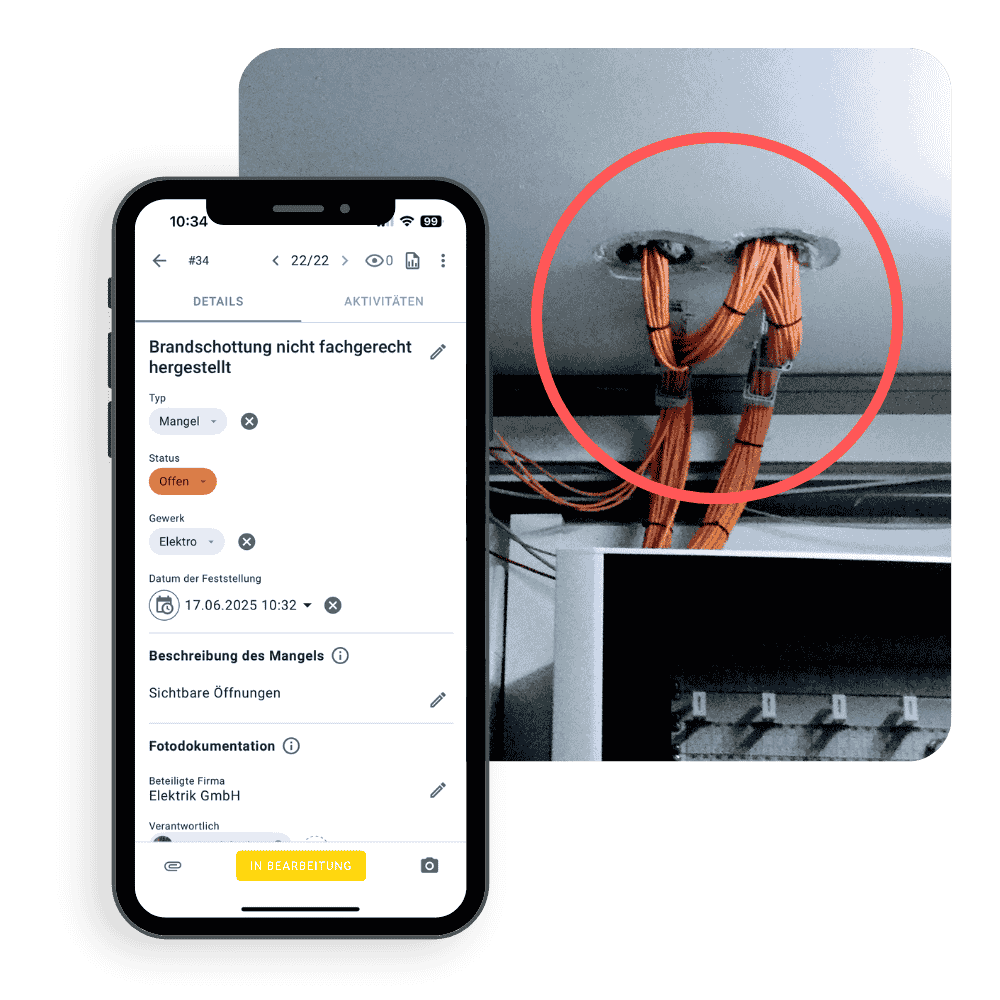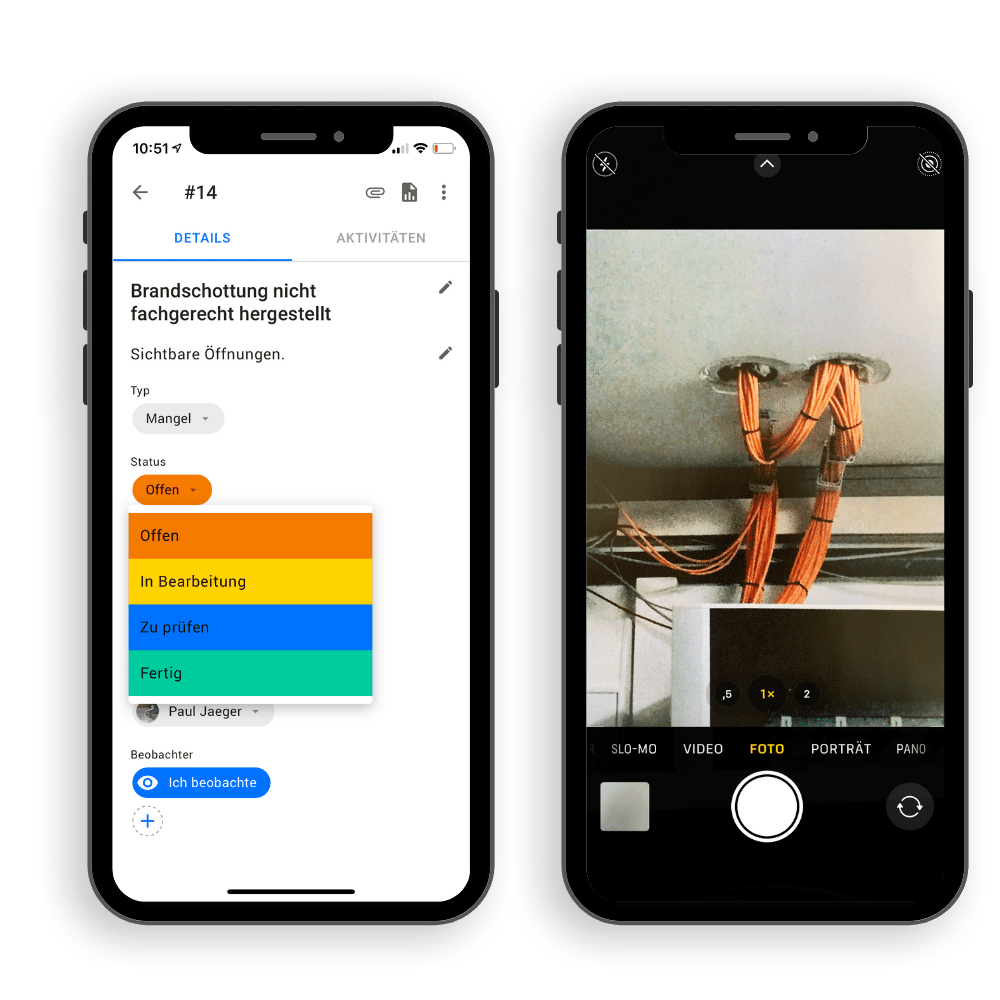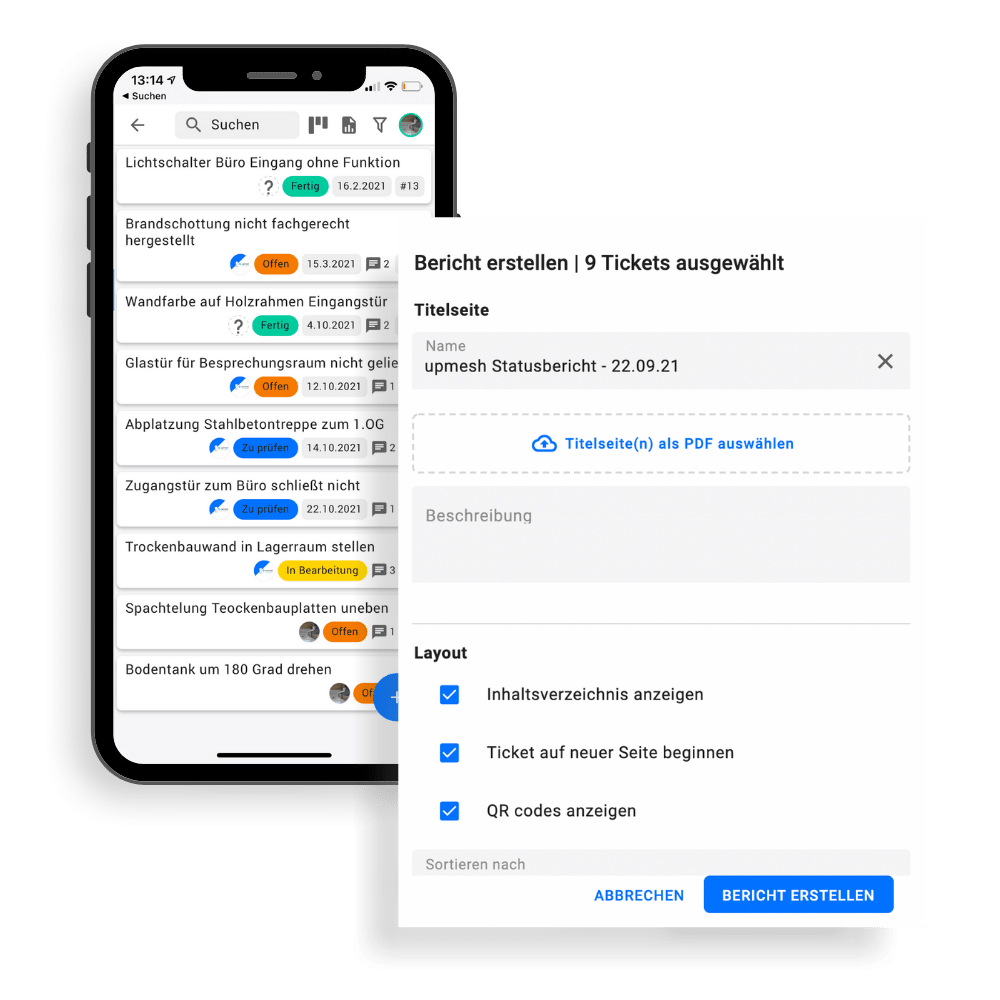Snag management
with plan reference, photo function & reporting
With the upmesh Snag management You can digitalize your defect management process, including photo documentation. From now on, you can record defects on-site and share them directly with other project participants – without any double entries or rework.


Record construction defects by photo
No more annoying Excel lists and unsorted photo collections. Record new defects on site with smartphone or tablet.

Assign & track defects
Instruct your team or subcontractors Tasks and follow transparent the Progress.
Complete photo documentation
Care for Evidence security and evaluable processes with a seamless Project documentation.
Simple and intuitive
Software for the
Defect management with photo documentation
Switch to digital defect recording and forget about inspections in which you had to carry heavy file folders, printed plans and a digital camera.
With the practical upmesh app for iOS & Android You can easily record construction defects. Add additional information such as description, trade, due date, photos and documents to communicate issues more efficiently – even without an active internet connection.



Efficient collaboration
Communicate directly via the defect management app
With upmesh defect management for the construction industry, you can define exactly who has to complete which task and by when in order to to accelerate construction processesSimply assign defects created for this purpose to a team member or subcontractor for processing and add a due date.
With the free upmesh account for subcontractors you don't waste valuable time. Inquiries or status changes both sides communicate directly withit messages, photos or documents inside the ticket.
React fast
From digital defect management with photo documentation
for reporting
Our Kanban board gives you a quick overview of the current status of the construction project. You can immediately see which tasks require your attention based on their status. Overdue defects are highlighted in color.
Create at the touch of a button meaningful reports that contain all relevant information such as descriptions, photos, plan sections and the complete communication history. With our report tool, you can also view all content and the Define the layout yourself. This ensures efficient defect management and helps you identify bottlenecks early on.

No more mess of paper.
Work digitally - with upmesh.
What our customers say about upmesh
Defect management?
To ensure seamless integration and manage the large number of stakeholders, general planner agn needed a tool that would support them in day-to-day project management, especially on the construction site. With over 850 architects, engineers, and specialists at 17 locations in Germany, upmesh has become an indispensable partner in day-to-day construction project management:
"The app is easy to use, so it's been embraced by all our project supervisors and the trades we support. upmesh listens to customer requests, takes them seriously, and implements them wherever possible. This means the app continually adapts to our needs. We manage almost all of our communication with all construction participants via upmesh, manage defect management and documentation (construction log) through it, and are also happy with the versioning function of the plan management."
Torsten Heywinkel, Managing Director of the agn Group
Do you need more information about upmesh defect management?
Talk to us.
Defects occur in every project; how you deal with them is crucial. With upmesh, you keep track: All defects are centrally documented, clearly assigned, and communicated transparently.
Would you also like to manage your deficiencies efficiently instead of chasing them?
Then write to us! We'll show you how easy it can be. Your request will land directly in our inbox and We will get back to you within 48 hours!
Frequently asked questions about defect management
Defect management refers to the structured process for recording, communicating, tracking, and documenting construction defects during the construction or warranty phase. The goal is to resolve defects quickly and transparently to avoid costs and delays and ensure the quality of the construction project.
Typical work steps in defect management are the identification and description of the defect, photographic construction documentation, assignment to a responsible trade or subcontractor, setting deadlines, communication about the processing status and the final control of the defect removal.
upmesh significantly simplifies this often tedious process: Defects can be recorded directly on-site using a smartphone or tablet and supplemented with photos, plan references, descriptions, and due dates. Interested? You can test the defect management app for free.
According to Section 633 of the German Civil Code (BGB), a defect exists if the actual condition of a building deviates from the contractually agreed desired condition. The agreed quality of the work is decisive for the assessment.
In the absence of an explicit agreement regarding quality, a structure is considered defective even if it cannot be used as usual or as expected. In the case of a VOB contract, the structure must comply with recognized engineering practices. Whether the contractor is responsible for the defect is irrelevant. Even so-called "cosmetic defects" that could reduce the value or lead to consequential damage are considered defects.
With upmesh, you can seamlessly document construction progress, providing legal certainty. The defect management app allows you to record every defect with photos, precise locations on the digital construction plan, and detailed descriptions. In the event of claims for recourse or disputes, you can generate informative reports at the touch of a button that contain all relevant information and serve as evidence.
In construction law, defects are classified according to their visibility and severity. Visibility is divided into obvious defects, which are immediately visible during a normal inspection of the building, and hidden defects, which are not detectable during the building inspection. Regarding severity, a distinction is made between significant and insignificant defects.
• Obvious defects: These are defects in the construction itself. Examples include cracks in the masonry, poorly executed paintwork, or poorly fitted doors. These defects are usually discovered during the construction phase or upon acceptance and should be recorded in the acceptance report.
• Hidden or concealed defects: These are often only discovered months or years after completion, when their consequences become apparent. These include, for example, leaking vapor barriers, faulty waterproofing, or poorly concealed installations.
• Major defects: These defects significantly prevent or impede the use of the completed building and must be remedied before acceptance. Examples include missing floors, significantly incorrect roof pitches, insufficient floor slope in the bathroom, or a foundation that is too short.
• Minor defects: These include minor faults that do not significantly affect the building and its use. Examples include dripping faucets, incorrect wall paint, or a few loose roof tiles.

Defect management software for construction, architecture and real estate
We comply with the EU General Data Protection Regulation (GDPR) and guarantee server locations in Germany with ISO 27001 certification.









